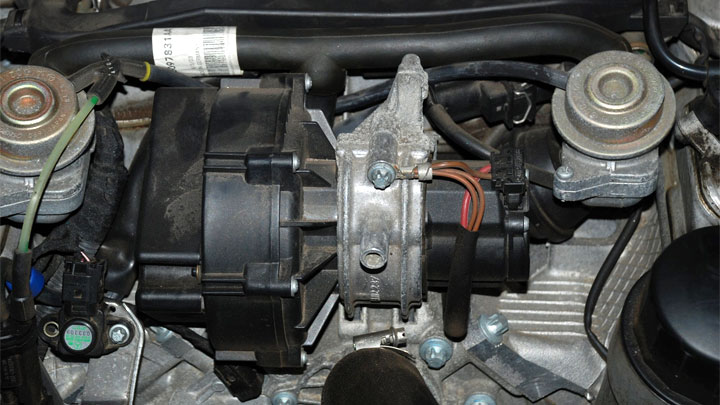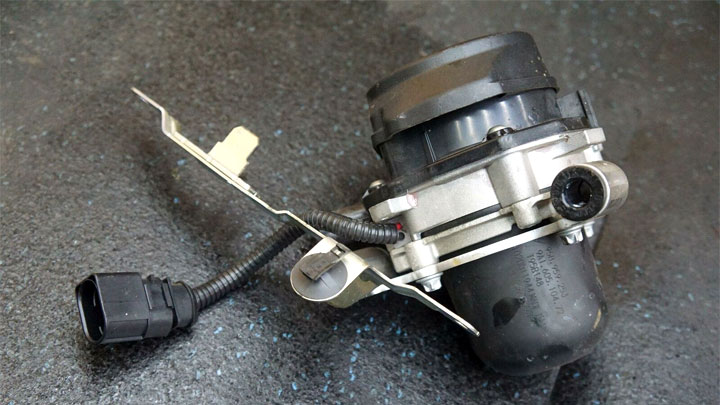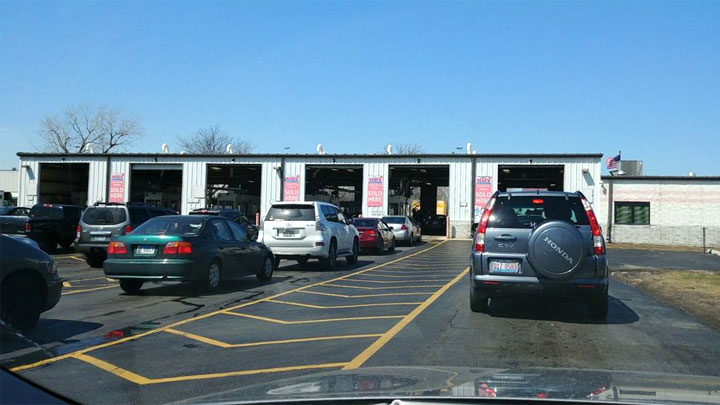4 Symptoms of a Bad Secondary Injection Pump (and Replacement Cost)
Sophisticated emissions components reduce vehicles’ environmental impact, meeting stringent regulations. One little-known device is the secondary air injection pump, pumping extra airflow post-startup to further neutralize exhaust. But with age, these pumps inevitably fail.
A variety of symptoms, from mild to serious, signal problems. We’ll explore what signs to watch for when this emissions helper needs help itself, and the associated costs to replace a secondary air injection pump.

What Is a Secondary Air Injection Pump?
Modern vehicles feature a specialty secondary air injection pump, which directs airflow into a vehicle’s exhaust stream. This is done to offset the naturally rich condition that is created during engine start-up.
This pump runs for approximately 30-120 seconds following start-up and is operated upon electrical request from a vehicle’s ECM/PCM.
This additional airflow is used to further neutralize a vehicle’s noxious emissions, especially in conjunction with exceedingly rich operating conditions. The presence of this fresh air assists in converting carbon monoxide into carbon dioxide, and hydrocarbons into condensation water. This, in turn, drastically reduces a vehicle’s carbon footprint.
Secondary air pump operation is monitored by a vehicle’s O2 sensors. The engagement of a vehicle’s secondary air injection pump is perceived by these sensors as a lean condition and is relayed to the vehicle’s ECM/PCM.

A lack of O2 sensor response to secondary air injection pump engagement is generally earmarked as a fault condition, resulting in the illumination of a check engine light.
Also included within the secondary air injection pump circuit is an air solenoid, relay, check valve, and assorted vacuum lines. A failure of any of these vital components can result in complete or partial system failure.
Other Components of a Secondary Air Injection System
While the pump is essential, there are other parts that make up a secondary air injection system to help reduce vehicle emissions.
- The control relay is responsible for regulating the electric pump. With the help of the engine control unit, this relay makes it possible for the pump to operate efficiently and be supplied with the required amount of air.
- The pneumatic control valve manages the airflow in the system. By regulating the air supply to the exhaust manifold, it helps complete the secondary combustion process.
- The combination valve works together with the pneumatic control valve. Its primary task is to prevent exhaust gases from entering the air pump. This safeguard maintains the system’s functionality and prevents damage to the pump.
- The engine control unit (ECU) acts as the brain and plays a pivotal role in coordinating all these components (and most other systems within a vehicle). It decides when to activate the air pump and adjusts the necessary parameters to ensure the secondary air injection system works efficiently.
Secondary Injection Pump Location
The pump is usually positioned at the front of the engine with the serpentine belt around it but can be hidden in some vehicles such as behind a plastic front wheel well liner. Either way, the placement must allow it to easily draw in air and direct it into the exhaust stream to help reduce emissions.
Bad Secondary Air Pump Symptoms
A failing secondary air injection pump is often accompanied by a host of additional symptoms, many of which vary significantly in severity. Those who recognize these symptoms are often able to quickly diagnose the issue at hand, thereby restoring their vehicle to proper operating condition in short order.
The following are the most common symptoms associated with secondary air injection pump failure.
#1 – Check Engine Light

One of the most obvious symptoms of a faulty secondary air injection pump is the sudden illumination of a vehicle’s check engine light.
This occurs when a vehicle’s ECM/PCM does not register a lean condition during secondary air injection pump engagement. The typical result is the storage of an active diagnostic trouble code such as: P0410, P0411, P0412, P2440, or P2442.
#2 – Erratic Idle

In many instances, a lack of secondary air injection pump operation will cause a vehicle’s engine to idle erratically. In certain cases, a vehicle’s idle will be reduced to a lower RPM, in turn causing the engine to stutter, or even stall altogether.
This is due to the obvious impacts that secondary air injection, or a lack thereof, has on O2 sensor feedback.
#3 – Reduced Performance

A vehicle’s overall performance can also be compromised with the failure of a secondary air injection pump. Under most circumstances, this reduced performance will be observed as an obvious lack of power during acceleration.
The severity of this symptom might, or might not, worsen with time.
#4 – Failed Emissions Test

The failure of a vehicle’s secondary air injection pump can also become evident during government-mandated emissions testing.
This is due to the fact that a vehicle’s exhaust output tends to be much richer at start-up, in the absence of a properly operating secondary air injection circuit.
What Can Cause the Pump to Fail?
An air injection pump can fail for several reasons, thereby causing a host of secondary issues as a result. The most common of these reasons are as follows.
#1 – Poor Power/Ground Delivery
Unusually high resistance within a secondary air injection pump’s power or ground circuits can often prove detrimental.
This stems from the fact that the pump in question is forced to work harder, generating additional heat, when attempting to operate with a marginalized power or ground supply.
#2 – Compromised Vacuum System
Vacuum system leaks and blockages also prove counterproductive to sound secondary air injection pump operation. Either of these conditions can cause a pump of this nature to struggle, thereby increasing wear and tear over the course of time.
#3 – Water Contamination
With time, water can infiltrate a vehicle’s exhaust system, thereby finding its way into a number of less than ideal places. In certain instances, this includes a vehicle’s secondary air injection pump housing.
Water contamination of this type is the leading cause of the corrosion, thereby effectively decreasing the service life of a vehicle’s secondary air injection pump.
#4 – Age
In some cases, a vehicle’s secondary air injection pump will fail for no other reason than the fact that it has reached the end of its useful service life.
Like any mechanical component, secondary air injection components are subject to normal wear and tear. As a result, aging pumps of this nature do occasionally fail.
Can You Drive Without a Secondary Air Pump?

Technically speaking, you can drive without a secondary injection pump. However, doing so is not advised.
This stems from the fact that a faulty secondary injection pump can cause a host of drivability-related issues, most of which can vary significantly in severity, on a case-by-case basis.
An inoperable secondary injection pump can cause your vehicle’s engine to respond erratically to throttle input, especially under heavy load. One can also expect to encounter a certain amount of backfiring when operating their vehicle with a faulty or otherwise inoperable secondary air injection pump.
Motorists might also find it impossible to license their vehicle in states or counties with mandatory emissions testing when attempting to operate with a faulty secondary air injection pump. This is due to the fact that this condition often causes an engine to run excessively rich at start-up.
Secondary Air Injection Pump Replacement Cost
Best places to order parts? See: 19 Best Online Auto Parts Stores
As with any repair, the exact cost associated with secondary air injection pump replacement varies significantly from one model of vehicle to the next. This stems from many variables, including the amount of labor time required to complete such a repair, as well as variances in the cost of a particular replacement air pump.
However, the average cost to replace the secondary air injection pump often falls within a general range. This range typically spans from $250-$450, with somewhere in the ballpark of $325 serving as a relative average.
Again, the actual price to complete such a repair will reflect the complexity of the job at hand, who works on it, as well as the price of the parts themselves.
- P0480 Code (Symptoms, Causes, and How to Fix) - Apr 19, 2024
- Car Temperature Gauge Stopped Working? (Here’s Why) - Apr 15, 2024
- Ignition Coil vs Coil Pack (What’s the Difference?) - Apr 8, 2024

I disconnected mine, and the engine runs fine. You can also pull the the fuse and or relay. Happy driving! Save some money on your trip.
Does the air injection and secondary air injection pumps cause a vehicle (Toyota Sr5V8) to vibrate when reaching speeds of approximately 48-60 mph.
If there is a leak, maybe. The secondary air injection typically only operates on cold start though.